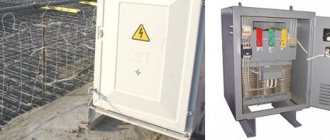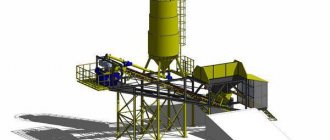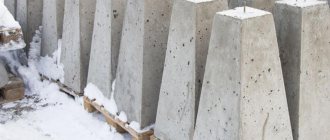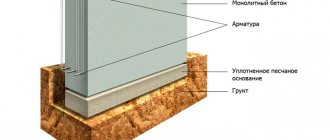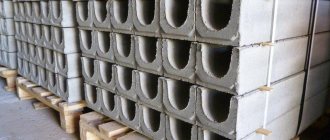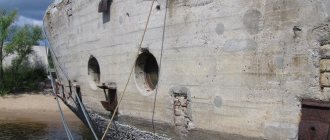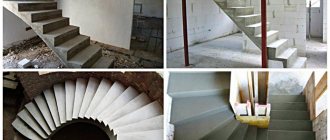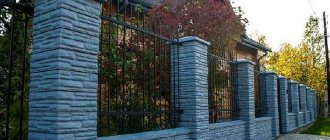Concrete housings for transformer substations are small structures for installation in outdoor conditions, which are widely used in power supply schemes of city networks for the purpose of receiving/converting current. Housings can be made in different configurations and provide many advantages in operation.
BKTP are gradually replacing closed transformer substations due to their simplicity, functionality and efficiency. Concrete buildings are made from high quality material, making the structures durable, waterproof, resistant to frost/heat, ultraviolet radiation, and other negative external factors.
Purpose
Concrete buildings for substations are used to receive energy, distribute it, and convert current.
These structures are used on electrical networks in facilities for a wide variety of purposes. These can be industrial enterprises, production areas, as well as suburban areas of varying degrees of remoteness from the city, urban networks in certain areas, etc.
Due to mobility and the ability to quickly and easily deliver package transformer substations (BKTP) to any point, concrete structures of this type are used everywhere and allow you to effectively perform the assigned tasks.
Kinds
Concrete buildings can be made in several versions. The choice depends on the operating conditions of the facility, connection features, and personal preferences of the customer. There are standard projects, and many companies can make reinforced concrete structures according to an individual project.
Main types of concrete complete transformer substation:
- Precast concrete housing
– is created from individual elements, which are subsequently processed, the joints are sealed, everything is painted. This option is considered the most economical, but structural elements may be subject to the spread of corrosion and are not able to withstand significant physical loads and impacts.
- Concrete transformer substation with removable roof
– such a body allows you to lift impressive equipment through the upper plane, for which you simply need to remove the roof slab.
- Housing with monolithic roof
– such a concrete substation has a high level of rigidity, so the walls are not too thick due to impracticality.
Doors and block
Doors and gate leaves of the BKTP open to an angle of at least 150° and are locked in extreme positions. Drainage canopies are provided above the gates and doors. Doors, blinds and locks are vandal-proof.
The basement volumetric block (hereinafter referred to as the block) is a rectangular monolithic reinforced concrete structure installed on a foundation slab. The walls of the block have openings with a thin-walled partition for cable entry and exit. To enter and exit cables, asbestos cement holes are installed in the punched holes, through which the cables are laid. After laying the cables, the holes are sealed with cement mortar and covered with a waterproofing compound.
Peculiarities
When concrete substation buildings are produced, the rules and all stages of the technology must be strictly observed, since this facility is subject to increased requirements for safety and more.
Main features of BKTP:
- Absolute nomenclature flexibility
- The need to implement modern mechanisms that demonstrate an increased level of security
- Ease and speed of installation work
- Requirement for a small building area
- Harmonious combination of the appearance of the building with the surrounding architecture
Concrete housings for transformer substations are very simple in design - it is a concrete box created according to a specific project. Thanks to the use of high-quality concrete in the production, the body is resistant to moisture, fire, frost, and ultraviolet radiation.
Inside the body there is a foundation and a main above-ground part; all structural elements are made of fire-resistant materials; they do not ignite even when exposed to open fire. In appearance, the enclosures are made as similar as possible to the objects of the surrounding architecture - they are painted in any color, in one combination or another.
Concrete substation buildings are delivered to the site by special transport and then installed at the specified location. Next, grounding is created, all cables are mounted and connected.
The main advantages of BKTP:
- Fast, simple and easy installation
- High quality workmanship - thick, durable walls, reliable roofing, sealed foundation (does not let oil into the ground) guarantee the reliability and durability of the structure
- Possibility to perform any finishing of gutters and walls
- Excellent heat saving and humidity characteristics inside the building
BKTP substations
In the conditions of dynamically developing electrical networks of the city, the use of BKTP is the optimal solution from both technical and economic points of view.
BKTP transformer substations consist of three main parts:
- Concrete shell (aerial part);
- Cable structure (underground part);
- Switching equipment.
The main ground structure of the BKTP substation consists of a reinforced concrete body. The load-bearing base and walls of the BKTP substation are made of high-quality concrete with volumetric reinforcement; fiber-reinforced concrete grade M350 is used in production, which makes it possible to obtain a completely monolithic structure that is not subject to the formation of chips and cracks. The underground structure for cable communications similarly has a monolithic reinforced concrete frame. Separate technological openings of the underground structure provide input/output of power cables. NIPO RusEnergo equips BKTP with dry and oil-filled transformers of high quality production.
- Production is carried out taking into account the regional rules for installing the customer’s electrical installations, which makes it possible to simplify the scheme for putting the BKTP into operation.
- Equipped with high quality transformers
- High seismic resistance of BKTP
- Attractive prices
- High readiness of BKTP for installation on site
Substation components
Housings for substations can consist of a different number of concrete compartments - one, two or three. Typically, concrete semi-basements are included in the design kit - an electric cable is passed into them, through the foundation and a special opening in the floor. The thickness of the walls of the building must be at least 80-100 millimeters, the floor is made of a load-bearing slab 10 centimeters thick and weighing 18 tons. The total weight of the structure includes the equipment.
Doors, gates and window bars are made of metal. A ventilation system must be installed in accordance with current building rules and regulations.
Substation components usually include the following elements: transformers, instruments for measuring/metering electricity, low/high voltage electrical installations.
The cost of a substation depends on the design features of the structural elements and various nuances: ventilation system, foundation, shell type, implementation of protection, input method. The price is also affected by the power and number of transformers, meters, grounding, circuits, number of lines, disconnectors.
CONCRETE KTP (BKTP) EKTA SERIES
GENERAL INFORMATION AND SCOPE OF APPLICATION
2BKTP-400/6/0.4 kV
Concrete complete block-type transformer substations (BKTPB) of the EKTA series are designed for receiving, converting and distributing electrical energy of three-phase alternating current with a voltage of up to 10 kV and a frequency of 50 Hz. They are used for power supply to cities, oil and gas industry enterprises, industrial enterprises, agricultural facilities, as well as cottage villages and individual development areas.
Both oil-filled and dry transformers with a capacity of up to 3150 kVA inclusive can be installed in the substation.
Structurally, the substation consists of a volumetric cable mezzanine, which is also the foundation of the BCTS, and a reinforced concrete building with an insulated ceiling and a lifting roof made of corrugated sheets.
TERMS OF USE
EKTA series PTS are designed to operate in the following conditions:
Altitude above sea level - up to 1000 m (operation at an altitude of more than 1000 m is allowed, but you should follow the instructions of GOST 15150-69, GOST 8024-90, GOST 1516.3-96 and GOST 12434-83). There is experience in installing BKTP at altitudes up to 3500 m.
Ambient air temperature – from -45 °C to +55 °C for version U1 and from -60 °C to +55 °C for version UHL1
The maximum permissible temperature inside the RUVN and RUNN units when putting equipment into operation is minus 25 °C.
Atmosphere type – II (industrial) according to GOST 15150-69
Climatic regions for wind and ice – I-III, for snow load – I-IV
SERVICE AND WARRANTY
The warranty period for the operation of the BKTP is 2 years from the date of shipment of the substation to the Customer, service life is 25 years
The manufacturer can perform the entire range of work on the construction of a substation, from project development to turnkey delivery of the facility.
MAIN PARAMETERS AND TECHNICAL CHARACTERISTICS
Table 1. Main parameters and technical characteristics.
| Parameter name | Parameter value |
| RUVN | |
| Rated voltage, kV | 6(10); 20 |
| Rated current of busbars, A | up to 2500A |
| Electrodynamic resistance current, kA | 41; 51 |
| Thermal resistance current (flow time 3 sec), kA | 16; 20 |
| RUNN | |
| Rated voltage, kV | 0,4; 0,69 |
| Rated current of busbars, A | up to 5900 |
| Electrodynamic resistance current, kA | up to 100 |
| Transformers | |
| Rated power of power transformer, kVA | up to 3150 |
| Climatic modification and placement category according to GOST 15150 | U1; UHL1 |
Table 2. Typical sizes of blocks and pits.
| Block type | Width, mm | Length, mm | Height, mm | Weight, t |
| RUVN block | 2500; 3000 | 5000; 5500; 6000; 6500 | 2560; 3070 | 12-18 |
| Power transformer block | 2500; 3000 | 5000; 6000; 6500 | 2560; 3070 | 12-15 |
| RUNN block | 2500; 3000 | 5000; 6000; 6500 | 2560; 3070 | 12-18 |
| Cable pit | 2500; 3000 | 5000; 6000; 6500 | 1600; 1900 | 7,5-10 |
At the Customer's request, blocks with other overall dimensions can be manufactured.
BKTPB DESIGN
The EKTA series BKTP is a one-story building consisting of reinforced concrete blocks of transport size, in which the equipment of RUVN, RUNN and transformers are located. The blocks are made of high-strength reinforced concrete with the following characteristics:
- concrete class for compressive strength – B25 (M350) GOST 26633-91;
- frost resistance concrete grade – F100;
- water resistance – W10
Structurally, the substation consists of a volumetric cable mezzanine, which is also the foundation of the BCTS, and a reinforced concrete building with an insulated ceiling and a lifting roof made of corrugated sheets.
Transformer gates and doors are made from cold-rolled steel 2.5 mm thick, painted with powder enamel (color as per customer’s request).
The cable entry and exit is made through asbestos-cement pipes laid through special openings in the foundation walls.
For access to the cable mezzanine, there are openings in the floor of the blocks, closed with metal hatches.
To maintain a given air temperature, the RUVN and RUNN units are equipped with electric convectors with a power of 1 kW or more, which can operate in both manual and automatic modes. Heating is controlled from the auxiliary needs box (ASN) installed in the RUNN.
Ventilation in the blocks is natural, carried out through louvered grilles installed on the doors and gates of the substation.
The substation is equipped with internal lighting of protection class 2. The lighting is controlled by key switches installed at the entrance to the switchgear room.
The RUVN and RUNN units are supplied in full factory readiness, the transformer unit is supplied without transformers.
The connection of power transformers from the HV side is made with a cross-linked polyethylene cable.
On the LV side there is a rigid busbar made of copper or aluminum.
Typical three-block layout. RUVN was performed on cameras KSO-393, RUNN on ShchO-70.
KSO-204M, KSO-211, KSO-393 cameras or KRU K-104 cabinets can be installed in the RUVN block. In the RUNN block there are panels of distribution boards of the type ShchO-70(90) or ShchonKU, ShNN.
Depending on the equipment installed in the substation, the layout of the substation changes, the number and dimensions of the blocks, as well as the number of transformers.
Based on RUVN blocks, it is possible to construct block-type distribution points (RP).
The safety of substation servicing is ensured by the internal grounding loop, which is laid inside each of the blocks. All elements that may be energized are connected to it.
At the request of the customer, additional equipment provided for in the project can be installed in the KTPB:
- automatic transfer transfer devices (ATS) on the high and/or low voltage side;
- electrical energy metering cabinets;
- uninterruptible power supplies;
- reactive power compensation devices;
- fire and security alarms;
- caissons for collecting transformer oil;
- primary fire extinguishing agents;
- Remedies;
- forced ventilation and air conditioning systems;
- drain pipes and basement flashings.
Concrete housings for substations
Modern manufacturers offer concrete housings for transformers, which are used to supply public, various types of industrial, and residential buildings. Concrete guarantees the structure protection from all influences (weather conditions, vandals, mechanical loads, etc.), provides strength and a long period of safe operation.
In addition, the use of concrete makes it possible to create buildings that are compact and lightweight, which do not require a large area on site. Enclosures can be installed for permanent or temporary use.
Moscow and the regions offer a fairly large selection of designs from many manufacturers, so it won’t be difficult to find or design what you need.
Types of temporary enclosures for transformers:
- Single transformer
– they are collected in conditions of power supply with interruptions of 24 hours or even less, and are also used if it is necessary to replace faulty parts or perform routine repairs
- Two-transformer
– are needed when operating an electricity receiver with category I/II. They are also installed during uneven schedules, under light load conditions, with the ability to turn off some if necessary and thus save money.
The lower part of the block, the ground structure, is designed for outdoor installation. Enclosures are created in accordance with the technical specifications provided by the customer, in the required dimensions and configuration. The inside and outside of the body are coated with textured paint.
The above-ground part of the body is a box made of durable reinforced concrete, created for the installation of electrical equipment. Usually the box is made of a simple rectangular or square shape, monolithic, with openings in the floor designed to descend into a large-volume block underground.
The RUNN and KRUVN cables are mounted and located there, and the oil is drained from the power transformer. Also in the floor there are guides for the transformer and embedded metal parts used to fasten equipment located inside the above-ground unit.
The underground pit is made in the form of a monolithic base of four walls with a floor recessed into the ground. This is both the foundation of the building and the installation site of the concrete platform where cable lines, gaskets, sectional jumpers and other elements of the system are installed. Access to them is provided by a removable ladder. To receive oil, it is possible to install a metal oil receiver of the specified volume.
Equipment in a concrete casing
Transformer substations in a concrete casing are used in the power supply of housing, communal, public and industrial buildings.
The concrete used is high quality, protected from any weather influences.
Operational and technical characteristics of block substations
Concrete buildings for substations are made of high quality heavy concrete grade B30 with a wall thickness of 100 mm.
This ensures excellent body performance:
- High strength concrete structure.
- Heat resistance.
- Waterproof.
Features that distinguish block-type complete transformer substations in a concrete housing are:
In the photo - a substation with brick walls (more expensive option)
- Lightweight and compact PTS.
- Reliability of reinforced concrete blocks made using the latest modern technologies for creating KTPB: Fire resistance.
- Vandal resistance.
- Weather resistance.
- The necessary strength.
Types of concrete transformer substations
Today, two types of block-packaged substations are used:
- Single-transformer KTPBs are installed for use under loads with an interruption in the supply of electric current for a day or less, during routine repairs or replacement of damaged components.
- Two-transformer substations are used with the primary use of power receivers of the first and second categories. The power of the transformers in them is adjusted so that when one of them is turned off, the second takes on the necessary load.
Note! Two-transformer substations are extremely necessary for uneven load patterns (daily or annual), regardless of the category of the end consumer of electricity. In this case, it is advisable to regulate the power of transformers for single-shift or two-shift operation with uneven shift loading.
Double-transformer KTPBs are advantageous in that during plant operation with light loads, some transformers can be turned off. In this case, the load is transferred through jumpers in the concrete casing to the secondary voltage substation. This economical mode of operation of the equipment guarantees minimization of power consumption of electrical equipment.
The metal case is used less and less in the modern world
Working conditions
When it comes to creating optimal conditions for transformer operation, it is worth studying the established rules and regulations.
Concrete transformer substations operate in the following conditions:
- The design of the housing must be made in accordance with regulations, state standards, and U1 markings.
- The product is installed outdoors in regions with a temperate climate.
- Ambient temperature: no higher than +45 degrees Celsius and no lower than -47 degrees.
- The level of ice/wind is one to four.
- The installation site is located no more than 1 kilometer above sea level.
- BKTP can be installed in fire and explosion hazardous areas, but in the absence of chemical gases and fumes.
- The level of seismic resistance of the area is up to 7 points on the Richter scale.
Transportation and installation
Delivery of BKTP can be carried out either by rail or road, exclusively in factory readiness, in a complete set. Transportation is usually carried out using low-loading cargo vehicles, so it is important to provide passage areas for them and the crane in advance. Before installing the housing, the area is cleared of dirt and debris, and special equipment is given access to it.
Preparing the site for installing a concrete casing:
- Carrying out measuring work, marking the territory
- Site preparation - soil compaction, laying sand in a layer 20 centimeters thick, creating a solid foundation if necessary
After arriving at the site, the body is unloaded and installed at the site. Next, connect all the cables and ground them.
Concrete housings for transformer substations are high-quality and durable structures that successfully and efficiently perform their assigned functions (subject to compliance with manufacturing technology and installation rules). Therefore, before proceeding with the selection of the housing and its installation, it is necessary to draw up a project and think through everything.
Conclusion
We hope that you will not have any difficulties in the process of searching for disparate design, production and installation organizations. Therefore, there will be no need to coordinate their actions, which, as a result, will somewhat reduce the costs of implementing the project and save nerves.
The main thing is to turn to a reliable partner who will guarantee a positive result and the quality of the equipment. In the videos presented in this article you will find additional information on this topic.
